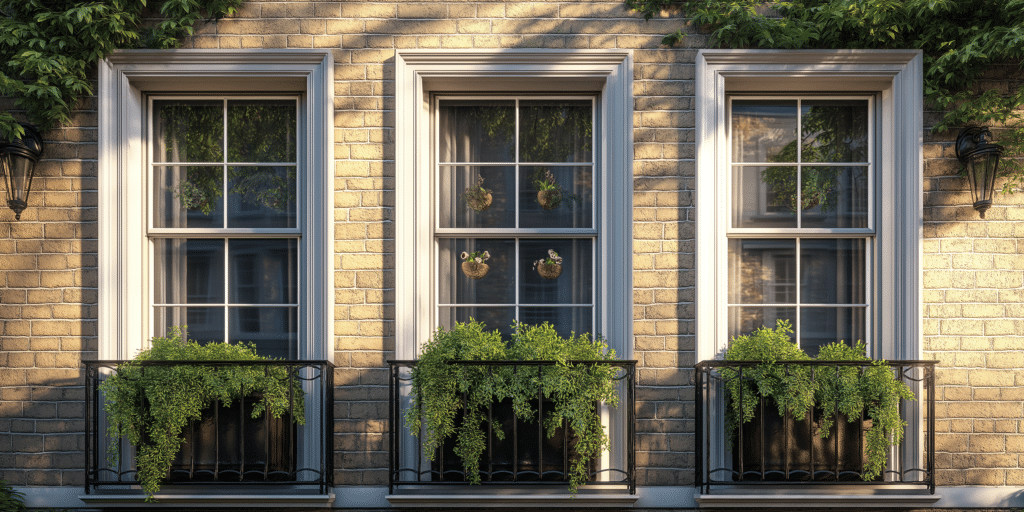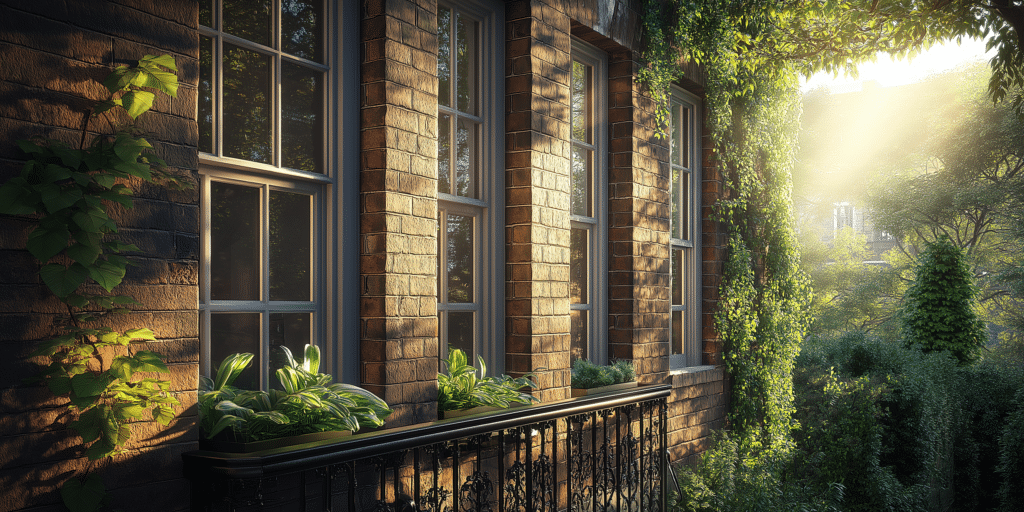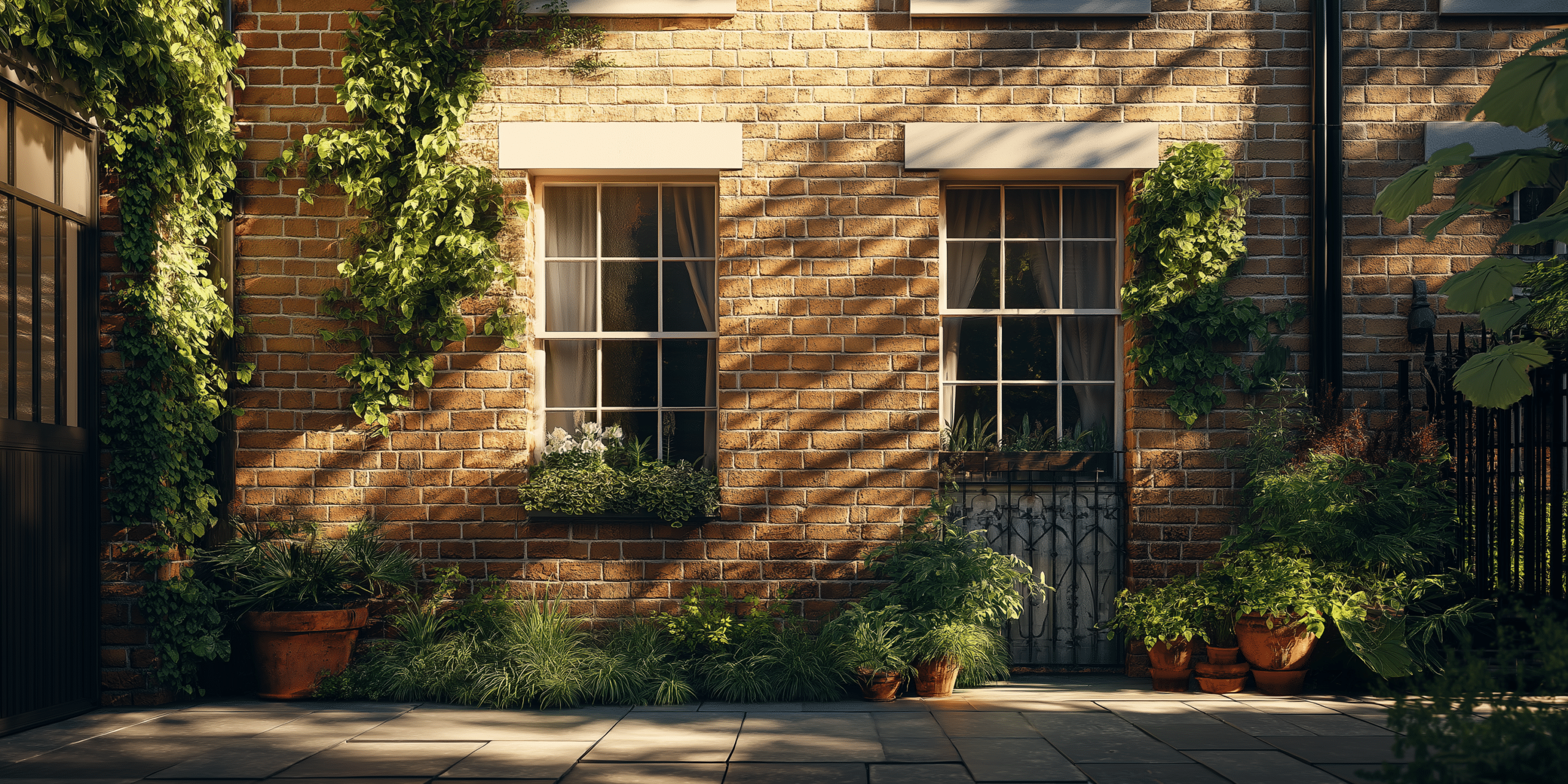What Are Sash Windows? Understanding the Basics

Sash windows, with their elegant design and practical functionality, are an enduring feature in British architecture. Commonly found in Georgian, Victorian, and Edwardian properties, sash windows consist of one or more movable panels known as “sashes” that slide vertically or horizontally within the frame. But why have sash windows stood the test of time?
One of the main reasons is the aesthetic appeal of sash windows, offering a unique combination of traditional design and modern performance. For example, Georgian sash windows are often built around the Golden Ratio, creating a visually balanced, proportionate, timeless look.
Sash windows allow for improved ventilation by enabling the user to open both the top and bottom sashes, ensuring better airflow compared to standard casement windows.
While originally made of timber, modern sash windows can be constructed using materials like uPVC and aluminium. They combine traditional aesthetics with increased durability and energy efficiency, making them a popular choice for conservation areas and listed buildings, where maintaining historical accuracy is crucial.
Innovations like double and triple glazing have significantly improved the energy efficiency of sash windows. They reduce heat loss while retaining the architectural charm of older properties. Double glazing, in particular, can decrease energy loss by up to 30%.
Key Components of Sash Windows: Breaking Down the Parts
Understanding the individual components of a sash window is essential before assembly begins. Each part ensures the window functions smoothly and provides adequate insulation and security.
- Traditional sash windows are typically made from timber, but modern variations now include uPVC, aluminium, and composite materials, offering greater weather resistance and energy efficiency.
- Sash cords and weights are essential for the balanced movement of the sashes. Proper maintenance of these parts is vital, as worn cords can cause operational issues and even cause the window to become stuck.
- Double glazing is increasingly popular in modern sash window designs, offering improved thermal insulation. Adding double glazing to traditional windows can reduce heat loss by 50%, especially in older properties retrofitted for better energy performance.
- Security features like sash window locks, often overlooked, play a crucial role in ensuring the window is secure and draught-proof, enhancing overall energy efficiency.
Preparation for Sash Window Assembly: Tools and Materials Needed
Proper preparation is key to a successful sash window assembly. Having the correct tools and a well-organised workspace can make all the difference between a smooth installation and a frustrating experience.
- Essential tools for assembling sash windows include a spirit level, chisel, putty knife, glazing hammer, and screwdriver. These tools help ensure accuracy in measurements and fittings.
- A clean and organised workspace is crucial to avoid assembly errors and potential accidents. Proper organisation also reduces the time spent searching for tools, making the process more efficient.
- Careful planning helps prevent common installation mistakes, such as misaligning the window frame, which can lead to issues with both function and insulation. Incorrect measurements can also lead to expensive rework.
- Safety precautions should always be considered, especially when working with glass and power tools. Wearing goggles, gloves, and ear protection minimises the risk of injury.
Step-by-Step Guide to Assembling Sash Windows

Now that you understand the components and have prepared your workspace, it’s time to assemble the sash windows.
- Use a spirit level to ensure the window frame is perfectly square and level during the initial fitting process. Misaligned frames can result in jammed or sluggish sashes.
- Correctly installing sash cords and weights is essential for balanced window movement. Measure the weight of the sashes to match the counterweights exactly.
- Installing the glazing bars requires precision for a professional finish. They must also be aligned properly to ensure a smooth and elegant appearance that matches both traditional and modern styles.
- Avoid common errors, such as improper glazing techniques or misaligning the frame, which can lead to poor insulation and operational issues.
Ensuring Proper Alignment and Functionality of Sashes
Testing the alignment and balance of the sashes is crucial in ensuring the functionality and smooth operation of the sash window. Poor alignment can cause jamming and operational failures.
- Use a spirit level to check that the window frame and sashes are correctly aligned, which will prevent operational issues such as jamming.
- The balance may be off if the sashes don’t stay open or are difficult to close. Adjusting the weights or replacing worn cords will usually resolve this issue.
- Over time, sash windows may require minor adjustments to maintain smooth operation. Regularly inspect and replace worn components such as cords, weights, or locks to keep them functioning correctly.
- Proper balance and weight distribution are crucial for a fully functional sash window. Expert advice suggests adjusting the weight increments carefully to match the sash weight for perfect balance.
Glazing Your Sash Windows: Methods and Materials
Glazing is a crucial aspect of sash window assembly, directly impacting energy efficiency, noise reduction, and security. The right choice of glazing can make a significant difference in the window’s overall performance.
Double glazing offers a good balance between cost and thermal performance, reducing heat loss by up to 50% compared to single glazing. It is an essential upgrade for homeowners looking to improve energy efficiency. Proper fitting of the glazing is vital to prevent leaks or draughts. Poor installation can result in condensation between panes, reducing the effectiveness of the insulation.
Traditional putty glazing is still widely used for period sash windows to maintain historical authenticity. However, modern alternatives like silicone or beading offer increased durability and flexibility. Ensure the glazing bars are securely attached and aligned with the window’s design. Misaligned bars can detract from the window’s appearance and reduce its visual impact.
Weatherproofing and Insulating Sash Windows

Proper weatherproofing and insulation are essential to enhancing the performance and longevity of sash windows. Using high-quality weatherstripping materials like draught-proofing brushes or silicone seals helps keep out cold air and moisture, improving the window’s overall insulation.
Draught-proofing can reduce heat loss by up to 30%, making sash windows more energy-efficient and comfortable for homeowners. Condensation between the panes of double-glazed windows can cause moisture issues, but proper sealing and ventilation will prevent this problem and maintain the window’s efficiency.
Weatherproofing can be done for historical properties without compromising on the aesthetic by using the conservation-approved draught-proofing method.
Finishing Touches: Painting and Sealing the Sash Windows
After the sash windows are assembled, applying the final touches like painting and sealing is crucial to enhancing both their appearance and durability. This section provides expert advice on protecting your windows while preserving their traditional look.
- Using exterior-grade paint with UV protection ensures the durability of the sash window, especially in areas exposed to the sun. This is crucial in maintaining both appearance and structural integrity.
- Sealants are essential for protecting sash windows from moisture. Using high-quality silicone sealants can prolong the lifespan of the window and improve its resistance to the elements.
- Paint both the interior and exterior of the window to ensure maximum protection and to prevent the wood from warping or rotting. Regular maintenance, including re-painting every 5-7 years, is recommended.
- Applying multiple thin coats of paint rather than one thick layer provides a smoother, more professional finish and reduces the chance of cracks and peeling.
Maintenance Tips for Long-Lasting Sash Windows

Regular maintenance is key to ensuring that your sash windows last for years. But what steps should you take to maintain them, and how often should these tasks be performed?
- It is recommended that sash windows be inspected at least once a year, paying close attention to balances, locks, and weatherstripping to ensure they remain functional.
- Regular lubrication of the sash cords and pulleys ensures smooth operation and prevents wear and tear. A silicone-based spray every six months is advised for lubrication.
- For timber sash windows, it is important to inspect the wood for signs of rot, especially around the sill. If rot is found, it should be treated immediately to prevent further damage.
- Cleaning the glazing and frame regularly helps to remove dust and debris that could impair the window’s function and reduces the chance of condensation forming between the panes.
Historical vs. Modern Sash Windows: Key Differences
Sash windows have a long history, with significant differences between historical and modern designs. Historical sash windows, such as those found in Georgian or Victorian homes, typically used single glazing and relied on heavy timber frames. Modern replicas, by contrast, use lighter, more efficient materials like uPVC or aluminium.
Acoustic glazing, a modern innovation, enhances noise reduction compared to historical windows, which often allows sound to pass through easily. Acoustic glass reduces noise by up to 70%.
Automated sash windows are now available, offering homeowners the convenience of remote control or smart-home integration, which adds a layer of modern comfort to this traditional design.
When working on listed buildings or conservation areas, it’s essential to use conservation-approved materials and methods to preserve the building’s historical integrity.
Common Problems and Solutions in Sash Window Assembly
Even with the best preparations, problems can arise during sash window assembly. Knowing how to troubleshoot common issues will help ensure your windows are fully functional. If the sashes are difficult to move or stick during operation, it is likely a result of poor alignment. Checking the frame’s alignment with a spirit level can help resolve this issue.
Proper sealing around the glazing is crucial to prevent draughts and leaks. Using high-quality weatherstripping can address this common problem. If the sash cords snap or the weights become unbalanced over time, replacing the cords or adjusting the weights can restore proper operation. Regular inspections will help catch these issues early.
Many minor issues, such as broken locks or loose glazing bars, can be addressed with simple repairs rather than full window replacement, saving time and money.
Final Thoughts: Mastering the Art of Sash Window Assembly

Mastering sash window assembly enhances the appearance of your home and improves its energy efficiency and value. By following this guide, you can ensure your sash windows are built to last, with minimal maintenance and maximum performance.
Regular maintenance and attention to detail are the keys to ensuring that your sash windows remain functional and aesthetically pleasing for many years. Balancing traditional craftsmanship with modern technology ensures you get the best of both worlds – the timeless appeal of sash windows with the added benefits of improved energy efficiency and security.
Understanding the process of sash window assembly can help homeowners save on long-term costs by reducing the need for professional repairs and improving the overall energy efficiency of the home.
In conclusion, sash windows are more than just a functional home feature. They are an investment in your property’s beauty and energy efficiency, providing long-term value.




